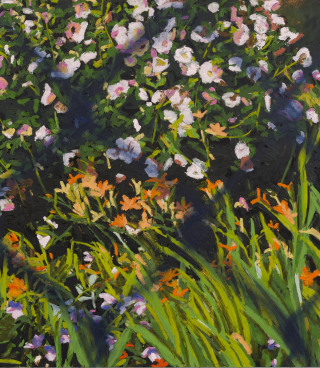Paul Anthony Smith Joins Timothy Taylor
Timothy Taylor is pleased to announce the representation of Paul Anthony Smith in London. The gallery will present an exhibition of new work by the artist at Frieze London in October 2024. In collaboration with Timothy Taylor, Jack Shainman Gallery will continue to represent Smith in New York.
Smith has garnered acclaim for his radical engagement with painting and photography in works that explore his own history as well as aspects of identity in the Caribbean. The Jamaica-born, New York-based artist documents candid scenes of friends, family, and community in New York and during travels to London and the Caribbean, reflecting on routes of migration, travel, and cultural memory. Across his work, Smith refers to borders, fences, barriers, and masks, alluding to the ways in which such forms variably serve to conceal, obfuscate, foreclose, and protect. As critic Seph Rodney observes, Smith belongs to a generation of artists who “carefully calibrate how and under what conditions [the black body] is seen.”
In 2012, Smith began incorporating a technique called “picotage,” in which he uses a retrofitted wooden needle to puncture the surface of his inkjet pigment prints, revealing the underlying paper-white support. In this way, he both erases passages of the original image and adds new visual information. These stippled marks introduce depth and texture to the image, reflecting the multifaceted and contingent narratives that always complicate the notion of truth and memory in photographic documentation. Smith’s picotage is often patterned to recall the perforated breeze block walls that were popular in midcentury architecture in the Caribbean; elsewhere the marks evoke Neo-impressionist pointillism and the ritualised scarification once common in West Africa. In his more recent Dreams Deferred series—mixed media works titled after the Langston Hughes poem—verdant landscapes are viewed through, and obscured by, the pattern of chain-link fence. The rhombic fencing calls to mind the social, cultural, and physical barriers that impact access and identity alike. At the same time, the patterned gestures to the pictorial language of geometric abstraction and its histories. In each series anew, Smith interweaves manifold references to suggest the hybridity and nuance of diasporic subjectivity.
“I am incredibly excited that Paul Anthony Smith has joined the gallery. I’ve been an admirer of his work for some time. His startlingly original use of traditional mediums––photography, oil paint, or picotage––reveals a complex and profound engagement with depth and surface, and between content and material. We’re thrilled to have our first presentation with Paul here in London this fall, and I am also looking forward to working collaboratively with Jack Shainman, who has known him so well.” —Timothy Taylor, Founder
Paul Anthony Smith was born in St. Ann’s Bay, Jamaica, in 1988 and raised in Miami, where he attended the New World School of the Arts. He studied ceramics at the Kansas City Art Institute (2010) and in 2014 moved to New York City, where he lives and works today. Recent solo exhibitions of his work have been organised by the Hyde Collection, Glens Falls, New York (2024), Blaffer Art Museum, Houston (2022); Kemper Museum of Art, Kansas City, Missouri (2022); Jack Shainman Gallery, New York (2021, 2019); Joslyn Art Museum, Omaha (2019); Luis de Jesus Los Angeles (2018); Green Gallery, Milwaukee (2018); ZieherSmith, New York (2017); and Atlanta Contemporary (2017). He has been an artist-in-residence at such venues as the MacDowell Colony, Peterborough, New Hampshire (2017); Anderson Ranch Arts Center, Snowmass Village, Colorado (2012); Nelson-Atkins Museum of Art and the Charlotte Street Foundation, Kansas City, Missouri (2017); Art in Buildings, New York (2014); and Art Omi, Ghent, New York (2013). His work resides in numerous public collections, including the Art Gallery of Ontario, Toronto; Blanton Museum of Art at the University of Texas, Austin; Joslyn Art Museum, Omaha; Minneapolis Institute of Art; and Nasher Museum of Art at Duke University, Durham, North Carolina.

